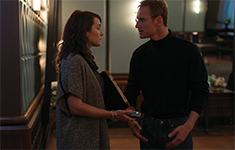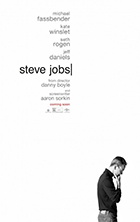Steve Jobs
|  Despite its resolutely unimaginative title, Steve Jobs is not your standard biopic, and for that it should be commended. Working from Walter Isaacson’s voluminous authorized biography of the Apple co-founder and closest thing the late 20th century had to a tech-inventor superstar, screenwriter Aaron Sorkin (The Social Network) avoids the clichéd “greatest hits” biographical approach and instead explores Jobs’s evolving character via his relationship with half a dozen people at three crucial moments in his professional life, each of which unfolds in something close to real time: the 1984 launch of the Apple Macintosh, the 1988 launch of the NeXT computer, and the 1998 launch of the iMac. On paper this tripartite structure is a great idea, as it allows Sorkin to depict the various intersecting threads of Jobs’s personal and professional life in a concise, controlled manner, but that is also the film’s fundamental problem: The narrative is so overtly structured that the structure itself starts to intrude on the drama as we become overly aware of the narrative circularity and repetitions of dramatic confrontation. Despite its resolutely unimaginative title, Steve Jobs is not your standard biopic, and for that it should be commended. Working from Walter Isaacson’s voluminous authorized biography of the Apple co-founder and closest thing the late 20th century had to a tech-inventor superstar, screenwriter Aaron Sorkin (The Social Network) avoids the clichéd “greatest hits” biographical approach and instead explores Jobs’s evolving character via his relationship with half a dozen people at three crucial moments in his professional life, each of which unfolds in something close to real time: the 1984 launch of the Apple Macintosh, the 1988 launch of the NeXT computer, and the 1998 launch of the iMac. On paper this tripartite structure is a great idea, as it allows Sorkin to depict the various intersecting threads of Jobs’s personal and professional life in a concise, controlled manner, but that is also the film’s fundamental problem: The narrative is so overtly structured that the structure itself starts to intrude on the drama as we become overly aware of the narrative circularity and repetitions of dramatic confrontation.The film’s strongest sequence is the 1984 Macintosh launch at De Anza Community College’s Flint Centre, if only because it has the virtue of not repeating what has come before; everything feels fresh and new. All of the central characters are quickly and efficiently established, as are the virtues and flaws of Jobs’s personality. As played by Michael Fassbender, Jobs is a relentless perfectionist who refuses to compromise on what he sees as “right”; while he can be charming, funny, and even self-deprecating at times, he is primarily depicted as a single-minded engine driving toward his goals with little—if any—thought for those around him. His management of other people shifts from boorish to downright cruel, which extends to his relationship with his ex-girlfriend, Chrisann (Katherine Waterston), with whom he has fathered a daughter, although he refuses to admit to paternity. In the first sequence Chrisann begs Jobs for money to get her and their 5-year-old daughter Lisa (Makenzie Moss) out of poverty, a request that Jobs finds, at best, annoying, although he reserves some of his iciest cruelty for Lisa, an innocent who represents to him little more than a stumbling block between him and “putting a dent in the universe” with Apple. Jobs is constantly flanked by Joanna Hoffman (Kate Winslet), his Eastern European marketing guru who ultimately stuck with him as his “work wife” throughout his entire career. She is the voice of measured reason, and therefore provides Sorkin a ready-made counterbalance to Jobs’s impolite obsessiveness. We meet Steve Wozniak (Seth Rogen), Apple’s other co-founder who begs Jobs to give public credit to the designers of the Apple II, the computer the Macintosh is essentially replacing, a request that Jobs vehemently refuses for reasons that are both practical (he wants to project a company looking to the future, not the past) and ego-driven (Jobs had nothing to do with the Apple II, therefore he has no interest in promoting it). Also on hand are Andy Hertzfeld (Michael Stuhlbarg), a programmer who comes to stand in for all the workhorses who did the actual labor on the machines that were essentially credited to Jobs’s brilliance, and John Sculley (Jeff Daniels), Apple’s CEO who Jobs personally recruited away from Pepsi and who became a kind of father figure to him. In each of the subsequent sequences—the NeXT computer launch, which was Jobs’s much anticipated second act following his being ousted from Apple in 1985, and the launch of the iMac, which kick-started Apple’s resurgence and finally made good on the promise that the original Mac failed to live up to—these same characters return in almost clockwork fashion, each emerging in the tense moments just before Jobs is set to go on stage to offer a compelling dramatic showdown that demonstrates how Jobs has either grown emotionally or remained in stasis. There are several recurring themes that thread the dramatic encounters together, including Jobs’s fixation with maintaining control (which is literalized in his engineers’ inability to open a malfunctioning Macintosh at one point) and his unwillingness to compromise in any way, which includes his strained relationship with Lisa (who is played as a 9-year-old by Ripley Sobo and as a young college student by Perla Haney-Jardine). The narrative convenience of the same characters shuffling on and off screen in each sequence allows Sorkin to condense a lot of material that would otherwise be widely scattered throughout Jobs’s life, but it feels overly mannered to the point of distraction. Fassbender and the rest of the cast are all duly impressive, and their conflicts have the kind of emotional flash and sharply edged dialogue that we have come to expect from anything bearing Sorkin’s signature, but the film underestimates the compounding effect of the narrative’s repetitiveness. This is not to say that it doesn’t work, but simply that it works with diminishing results. Director Danny Boyle (Slumdog Millionaire), a dynamic director whose primary weakness is his tendency to add flash where it isn’t needed, keeps the razzle-dazzle in check and plays the drama fairly straight. He utilizes a number of long takes, which allow his actors to shine, and he keeps the camera mobile, following Jobs and the other characters as they move in and out of the backstage chaos. The visual movement enhances the film’s narrative momentum, even if it isn’t quite enough to overcome the fundamental problem with its structure. Boyle does give in to some of his worst tendencies from time to time, including a scene in which Jobs uses the example of NASA launching a probe into space without knowing how to get it down as a corollary to the operating-system-less NeXT computer, and Boyle can’t help but turn the long white wall behind him into a screen showing a launching NASA rocket. It’s a distracting visual that is utterly unnecessary, although the fact that it stands out so much is evidence of how generally restrained Boyle is throughout the film. Copyright ©2015 James Kendrick Thoughts? E-mail James Kendrick All images copyright © Universal Pictures |
Overall Rating: 

 (2.5)
(2.5)


